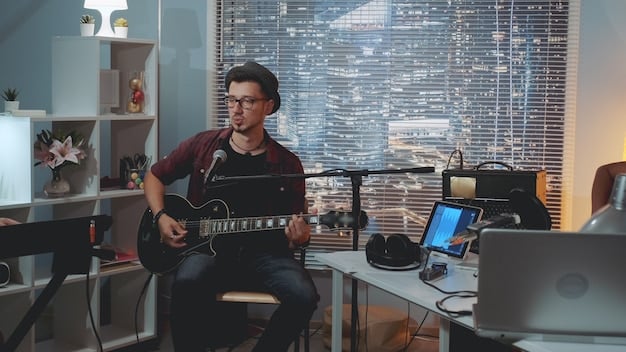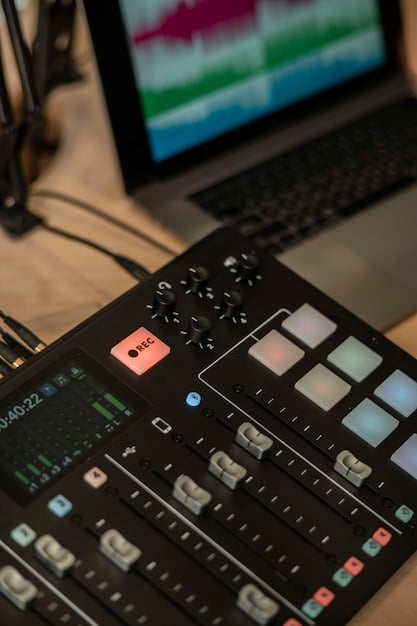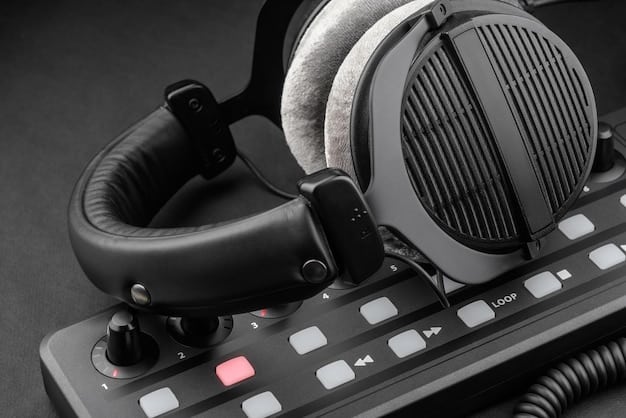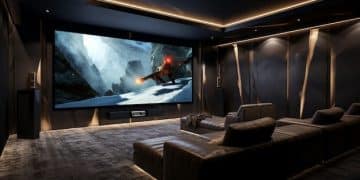Mastering Music Production: 5 Budget-Friendly Tools for US Musicians

Mastering music production on a budget is achievable for US musicians by leveraging affordable, yet powerful tools such as DAWs, audio interfaces, microphones, headphones, and MIDI controllers, all available for under $500.
Embarking on a journey into music production can feel daunting, especially when considering the costs involved. However, mastering music production on a budget is entirely possible, and this guide will illuminate five essential tools that US musicians can acquire for under $500 to kickstart their home studios.
Creating Music Magic Without Breaking the Bank
For aspiring musicians in the US, the dream of creating high-quality music often collides with the reality of limited financial resources. Fortunately, the advancements in digital music technology have made it possible to assemble a capable home studio without spending a fortune. Let’s explore five essential tools that can help you achieve professional-sounding results while staying within a $500 budget.
This guide aims to provide practical advice and recommendations, ensuring that you can make informed decisions and invest in the tools that best suit your musical aspirations. We’ll explore digital audio workstations (DAWs), audio interfaces, microphones, headphones, and MIDI controllers, all crucial components of a modern music production setup.
Choosing the Right DAW for Your Needs
The heart of any digital music production setup is the Digital Audio Workstation (DAW). This software serves as your recording studio, mixing console, and mastering suite, all in one. The good news is that several excellent DAWs are available within our budget, offering a range of features suitable for various musical genres and production styles.
While some DAWs come with a hefty price tag, many offer free or affordable versions that are perfect for beginners and even seasoned producers. For example, GarageBand is a free and powerful option for Mac users, while Cakewalk by BandLab is a popular free choice for Windows users. Both DAWs offer a comprehensive set of tools for recording, editing, and mixing audio.
- GarageBand: Ideal for Mac users, offering a user-friendly interface and a wide range of virtual instruments and effects.
- Cakewalk by BandLab: A robust DAW for Windows users, providing a professional-level feature set at no cost.
- Tracktion Waveform Free: Another excellent free DAW with a modular interface and a wide range of features.
Selecting the right DAW is a critical first step in your music production journey. Take some time to explore the available options, try out the free versions, and choose the DAW that feels most intuitive and inspiring to you.
The Importance of a Quality Audio Interface
An audio interface acts as the bridge between your instruments and your computer, converting analog signals into digital data that your DAW can understand. It also provides clean, low-noise amplification for your microphones and instruments. Investing in a quality audio interface is essential for capturing professional-sounding recordings.
Focus on interfaces that offer at least one or two microphone preamps, as well as instrument inputs for guitars or keyboards. Low-latency performance is also crucial, ensuring that you can record and monitor your audio in real-time without distracting delays. Many affordable interfaces offer excellent sound quality and low-latency performance, making them ideal for home studio use.

Top Audio Interface Options Under $500
Fortunately, there are several fantastic audio interfaces available for under $500 that deliver exceptional sound quality and reliability. These interfaces offer features such as low-noise preamps, high-resolution converters, and versatile connectivity options, making them ideal for a wide range of recording applications.
When choosing an audio interface, consider the number of inputs and outputs you need, the types of instruments you plan to record, and the software compatibility of the interface. Also, be sure to read reviews and compare specifications to find the interface that best suits your needs and budget.
- Focusrite Scarlett Solo: A popular choice for solo musicians, offering a single microphone preamp and instrument input.
- PreSonus AudioBox USB 96: A versatile interface with two microphone preamps and MIDI I/O.
- Steinberg UR22C: A high-quality interface with excellent sound quality and low-latency performance.
Investing in a good audio interface will significantly improve the quality of your recordings, providing clean and accurate audio signals for your DAW to process. A quality audio interface is an investment into higher quality sound recordings and better mixes.
Microphones: Capturing Your Sound on a Budget
The microphone is the primary tool for capturing sound, whether it’s your voice, an acoustic instrument, or an amplifier. While high-end microphones can cost thousands of dollars, there are many excellent budget-friendly options that can deliver professional-sounding results in a home studio.
Consider different microphone types depending on your recording needs. Condenser microphones are ideal for vocals and acoustic instruments due to their sensitivity and detail, while dynamic microphones are more robust and suitable for loud sources like drums and guitar amplifiers. USB microphones offer a convenient and affordable option for beginners, connecting directly to your computer without the need for an audio interface.
Choosing the Ideal Microphone for Your Studio
Selecting the right microphone for your studio setup is critical, as it determines the quality and characteristics of your recordings. Different microphones excel in different applications, so it’s important to consider your recording needs and choose a microphone that complements your voice or instrument.
For vocals, a large-diaphragm condenser microphone is often the preferred choice, capturing nuances and details with clarity and warmth. For drums and amplified instruments, a dynamic microphone is more suitable, handling high sound pressure levels without distortion. USB microphones offer a convenient and affordable option for podcasting, voiceovers, and simple music recording.
- Audio-Technica AT2020: A popular condenser microphone for vocals and acoustic instruments.
- Shure SM57: An industry-standard dynamic microphone for drums, guitar amplifiers, and vocals.
- Blue Yeti: A versatile USB microphone for podcasting, voiceovers, and music recording.
Investing in a quality microphone is a worthwhile investment for any musician or producer, enabling you to capture professional-sounding recordings that capture the true essence of your music.
Headphones: Your Critical Listening Tool
Headphones are an indispensable tool for music production, providing a private and focused listening environment for mixing, editing, and monitoring your audio. Choosing the right headphones can significantly impact the accuracy and clarity of your mixes, ensuring that your music sounds its best on a variety of playback systems.
Consider closed-back headphones for recording, as they provide good isolation and prevent sound leakage into your microphone. Open-back headphones are ideal for mixing, offering a more natural and spacious soundstage. Look for headphones with a flat frequency response, ensuring that all frequencies are reproduced accurately without coloration.

Affordable Headphones for Music Production
Fortunately, there are many excellent headphones available for under $500 that are designed specifically for music production. These headphones offer a combination of comfort, accuracy, and durability, making them ideal for long hours in the studio.
When choosing headphones, consider the size of the earcups, the weight of the headphones, and the frequency response. Also, be sure to read reviews and compare specifications to find the headphones that best suit your needs and preferences.
- Beyerdynamic DT 770 Pro: Closed-back headphones with excellent isolation and a detailed sound.
- Audio-Technica ATH-M50x: Versatile headphones with a flat frequency response and comfortable fit.
- Sennheiser HD 280 Pro: Durable headphones with good isolation and a clear sound.
Investing in a good pair of headphones is essential for making critical listening decisions and ensuring that your mixes sound their best. The headphones are an essential tool in the music production workflow.
MIDI Controllers: Expressing Your Musical Ideas
A MIDI controller allows you to interact with your DAW and virtual instruments in a tactile and expressive way. Whether you’re playing melodies on a keyboard, triggering samples on a drum pad, or tweaking knobs and faders, a MIDI controller can greatly enhance your workflow and creativity.
Consider the size and features of the MIDI controller, as well as its compatibility with your DAW. A keyboard controller with velocity-sensitive keys is ideal for playing virtual instruments, while a pad controller is perfect for triggering samples and creating drum patterns. Look for controllers with assignable knobs and faders, allowing you to control parameters in your DAW and virtual instruments.
Selecting the Right Midi Controller for Your Studio
Choosing the perfect MIDI controller hinges on your specific requirements and workflow preferences. Some producers prioritize keyboard controllers for their expressive capabilities with virtual instruments, while others favor pad controllers for their intuitive drum programming and sample triggering.
Regardless of your preference, several affordably excellent options exist for launching MIDI from your home studio. With a MIDI controller, you can take your ideas into your software for recording and mixing.
- Akai Professional MPK Mini MK3: A compact keyboard controller with velocity-sensitive keys and assignable knobs.
- Novation Launchpad X: A versatile pad controller for Ableton Live, with velocity-sensitive pads and customizable layouts.
- Arturia MiniLab MkII: A portable keyboard controller with a wide range of controls and bundled software.
A MIDI controller is a valuable tool for any music producer, providing a hands-on and expressive way to interact with your DAW and virtual instruments.
| Key Point | Brief Description |
|---|---|
| 💡 DAW Selection | Choose a free or affordable DAW like GarageBand or Cakewalk. |
| 🔊 Audio Interface | Essential for quality recording; Focusrite Scarlett Solo is a good option. |
| 🎤 Microphone Choices | Select a condenser (AT2020) or dynamic (SM57) mic based on your needs. |
| 🎧 Headphones | Closed-back (DT 770 Pro) or open-back; prioritize a flat frequency response. |
FAQ
▼
The most crucial tool is a DAW, as it’s the central hub for recording, editing, and mixing audio. Choosing the right one will set the foundation for your entire workflow, directly impacting the quality of your music.
▼
Absolutely! With free DAWs and affordable equipment like the Focusrite Scarlett Solo audio interface and Audio-Technica AT2020 microphone, you can achieve impressive results without overspending. Creativity and ingenuity are key.
▼
Closed-back headphones are preferable for recording to reduce sound leakage, while open-back headphones are ideal for mixing due to their natural soundstage. The Beyerdynamic DT 770 Pro offers excellent isolation and detail.
▼
Yes, an audio interface is crucial for capturing high-quality audio, providing clean preamps for microphones and instruments. It also reduces latency for live recording and monitoring, making it essential for serious music production.
▼
A large-diaphragm condenser microphone, like the Audio-Technica AT2020, is often the preferred choice for recording vocals. It captures nuances and details with clarity and warmth, enhancing vocal recordings.
Conclusion
Mastering music production on a budget is not only feasible but also empowering. By strategically investing in essential tools such as a DAW, audio interface, good microphone, studio headphones, and MIDI controller, aspiring US musicians can create professional-quality music from the comfort of their homes. With creativity, resourcefulness, and the right equipment, the possibilities are endless.





